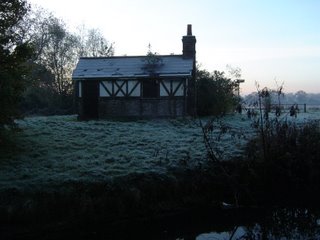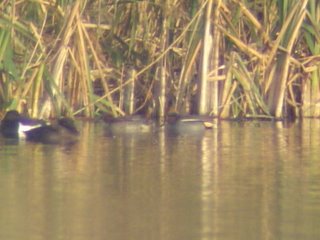Mediterranean Gull (1st winter)
Caspian Gull (adult)
wintering Water Rails, Green Sandpipers & Common Snipe
Tawny Owls rediscovered in Abney Park Cemetery
records refer to Stoke Newington Reservoirs unless otherwise stated
After the last summer visitors had departed in October, the winter was predictably harder work. Notable records were regular, however, characterised by passage and wintering wildfowl (including Teal, Wigeon and Red-crested Pochard), several significant gull records (including Caspian and Mediterranean), and an assortment of impressive winter visitors (including Water Rails, Green Sandpipers and Common Snipe).

(New River East, November 2005)
Wildfowl counts:
Wildfowl numbers were counted on average at least once a week from November to March inclusive, to get a clearer picture of wintering status and movements. The results (for Nov-Feb) can be summarised as follows.
Mute Swan - always present; usually between six and 12, peak of 17 on 9/11, low of 4 on 15/2. Canada Goose - usually present; unpredictable in numbers, but usually single figures. Peak of 34 on 18/12. Greylag Goose - occasionally present; one on 26/1, two on 1/2 and 21/2.
Mallard - always present; 15 to 35 birds. Gadwall - always present; relatively consistent in numbers, with between 25 and 45 usually recorded. Peak of 65, 18/12. Shoveler - always present; variable in numbers, but usually between five and sixteen present. Peak of 30 on 9/11, low of 2 on 6/12. Wigeon - occasional; four on 9/11, singles on 20/11, 6/12 and 27/12. Teal - regularly present in small numbers. Up to four birds thought to have wintered, although were not always present (or were unviewable) and birds may have 'overlapped'. Peak of four on 24/1.

(Teal, November 2005)
Pochard - always present; consistent after a low of eight on 9/11 , with between 25 and 45 on most dates. Red-crested Pochard -occasional; two records from the period, one on 6/12 and seven on 7th Jan. Tufted duck - always present; usually 30 to 50, Peak of 60 24/11, low of 25 on 1/2. Ruddy Duck - alway present; low of 12 on 9/11, but numbers built up 30 by the end of Nov., and consistently 25 -35 thereafter. Peak of 42 on 2/1.
Gulls provided most of the interest in the winter months, with several good records during the period. The pick of these were a first winter Mediterranean Gull on the 4th Feb., and an adult Caspian Gull on the 1st (both with congeners on the East Reservoir). Great Black-backed Gulls - a scarce visitor to the area - were recorded on 14th Dec (first winter), 11th Jan (adult) and 15th Jan (adult).

(male Wigeon, December 2005)
Numbers of the commoner gulls were monitored at least weekly; Black-headed Gulls, after building steadily during October, numbered over a hundred by 20th Nov, and remained consistent thereafter with between 120 and 200 birds on most visits (peak of 320 on 27th Dec.). Common Gulls returned on 9th Nov (4), and counts usually fell between 15 and 30 consequently, with a peak of 47 on 2nd Jan.
Herring gulls were also always present, with usually between five and 12 recorded, peaking at 23 on 27th Dec. An adult showing characterisitics of the Scandinavian race L.a.argentatus was present on 8th Feb. Lesser Black-backed Gulls were marginally more numerous, with counts of between 10 and 20 the norm (with a peak of 31 on 24th Nov).

(East Reservoir, November 2005)
Waders were, relatively speaking, well represented at the reservoirs during the winter months. The first Common Snipe arrived on 20th Nov, after which one to two birds were recorded on the majority of visits. Whether these records involved the same birds throughout, or a series of 'overlapping' records, is unknown, but three feeding together on the shore of the WR on 24th Jan showed movements continued well into the winter.
The first Green Sandpiper arrived on 14th Dec, joined by a second bird from the 24th Jan. Either one or two were seen on each visit, and - as above - the true status remains unknown, but it was thought more likely that just two individuals were involved.

(Wigeons on West Reservoir, 9th Nov 2005)
Water Rails provided respite on many an unproductive midwinter day, often seen as well as heard, and often in territorial dispute. At least four birds wintered, although again theoretically more birds may have been involved. Great Crested Grebes were present throughout, with one to two birds usually recorded, joined by a third during most of December. Little Grebes were seen on most occasions, with one to four (usually three) birds present.
Sparrowhawks were by far the most reliable raptor, with one or two recorded on most visits. Kestrels were, however, only occasional during this period; more regular sightings came from Clissold Park and Geldeston Road. The only record of Peregrine for the period came from the West Reservoir on 9th Nov.One to two wintering Kingfishers were seen on most visits, both favouring certain stretches of the New River.

(male Kestrel, Geldeston Rd, Nov 2005)
Two wintering Chiffchaffs were present on a number of occasions, joined by a third on 18th Dec, usually favouring the willows along the New River east. Yet to be blessed or cursed with breeding Ring-necked Parakeets, two records over Geldeston Road in Nov and Dec were unusual for the area (the former passing over Abney Park Cemetery a few moments later).
The winter flock of Long-tailed Tits numbered up to 16 birds, often including a Chiffchaff or two and several Goldcrests. The commoner finch species were joined by Lesser Redpolls on 20th Nov (two), 18th Dec (three) and Feb 2nd (seven), and three Bullfinches on 24th Nov. Winter thrushes were in evidence mainly during Nov and Dec, with eight Fieldfares on 24th Nov and 27th Dec and one on 27th Feb, and Redwings present on several dates, peaking at 12 on 24th Nov.
An exploratory visit to Abney Park Cemetery after dusk on 25th Jan to check for Tawny Owls produced instant success; no less than three birds responded to short bursts of tape (one within 30 seconds). This is the first confirmed record for several years and strongly implies a breeding presence in the cemetery.
Abney also held up to eight Goldcrests during Jan and Feb, when Coal Tits were seen and heard singing on several occasions.